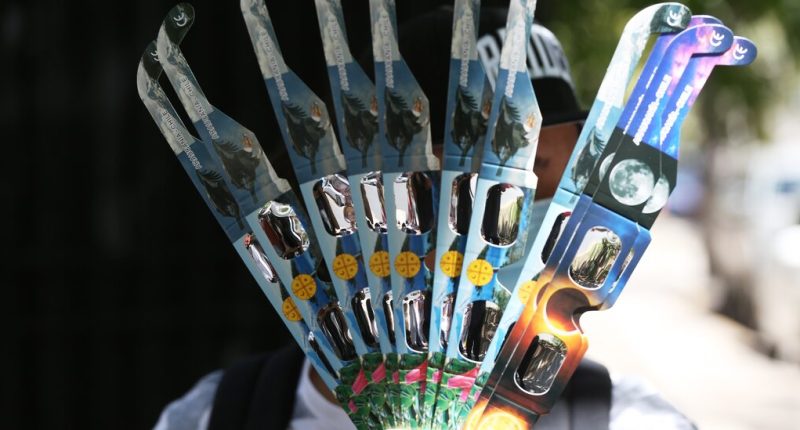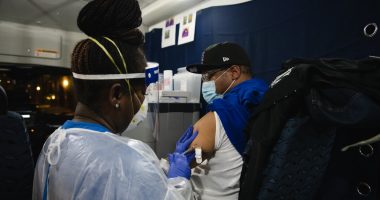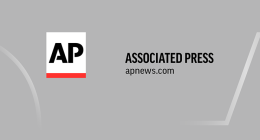A young woman visited New York Eye & Ear Infirmary of Mount Sinai Hospital shortly after the eclipse of Aug. 21, 2017. She told Dr. Avnish Deobhakta, an ophthalmologist, that she had a black area in her vision, and then drew a crescent shape for him on a piece of paper.
When Dr. Deobhakta examined her eyes, he was astonished. He saw a burn on her retina that was exactly the same shape. It was “almost like a branding,” he said.
She had looked at the sun during the eclipse without any protection. The burn was an image of the sun’s corona, its halo-like outer rim.
With every eclipse, ophthalmologists see patients who looked at the sun and complain afterward that their vision is distorted: They see small black spots, their eyes are watery and sensitive to light. Usually, the symptoms resolve, although it may take several weeks to a year.
But the woman’s retinal burns, which Dr. Deobhakta and colleagues described in a medical case write-up, would not heal. Her retina was permanently scarred and a sign of the severity of injuries that can follow looking at an eclipse without proper precautions.
With the coming eclipse in April, ophthalmologists advise people to be careful and not assume that short glances at the sun are safe. Damage can occur, they say, in less than a minute.
David Calkins, director of the Vanderbilt Vision Research Center and vice chair of the Vanderbilt Eye Institute in Nashville, said younger people were most at risk of retinal injury, possibly because the lens of their eye is clearer than the lens in older people. He said they also may be a bit more reckless.
But age is no guarantee of safe eclipse viewing.
A study described 20 people aged 15 to 82 in England who complained of symptoms like black spots in their vision or blurry vision after an eclipse in 1999. Four said they used eclipse glasses; one said she used sunglasses. The rest looked with naked eyes.
Five had visible damage to their retinas. All but four of the 20 were better after seven months.
Not everyone is so lucky. A study published last year involved four young Irish women who looked at the sun during a religious gathering in October 2009. The women, who did not know one another, sought medical attention within a few days of looking at the sun. They complained of blind spots in the center of their vision and said objects appeared distorted and blurred.
Investigators from Galway University Hospital followed up with the women for an average of more than five years. One was followed for 11 years.
Years later, the researchers reported, all of the women still had the blind spots.
For Dr. Deobhakta, the situation with the woman in 2017 is a cautionary tale.
While she did put on protective glasses for part of her viewing of the eclipse, she at first looked at it several times for about six seconds each time without protection.
She felt fine for four hours. Then her symptoms emerged: blurred vision, distorted shapes and colors, and that crescent-shaped black spot in the center of her vision with her left eye.
Most people look at an eclipse through special eclipse glasses. Often the glasses have a cardboard body with special film in the eyeholes that filters out harmful rays.
Dr. Deobhakta said he did not trust many of the eclipse glasses being sold and felt it was not worth taking a chance on them. He prefers an indirect method that involves using pinholes, like in a colander, to cast the sun’s shadow on the ground.
Professional groups say many eclipse glasses are safe but urge caution when buying them. The American Astronomical Society reported that potentially unsafe eclipse glasses flooded the market before the 2017 eclipse.
To help people find eclipse glasses, the astronomical society lists reliable sellers and distributors.
Legitimate eclipse glasses must meet specific international safety standards known as ISO 12312-2. Testing requires a spectrophotometer that measures how much ultraviolet, visible and infrared light gets through the glasses.
But an ISO logo on the glasses is not necessarily an assurance, the astronomical society warns, because dealers can — and some do — snatch an ISO logo from the internet and put it on their glasses.
Rick Fienberg, project manager of the astronomical society’s Solar Eclipse Task Force, said counterfeiting companies were also putting the names of legitimate distributors on their products. That doesn’t necessarily mean they’re unsafe, he added. But it does mean that the seller, or the company that sold it the products, is committing fraud.
Dr. Fienberg suggests buying directly from a seller on the astronomical society’s list.
But, he said, if you are worried about your glasses, there is a way to see if they are effective. Look around a room with the eclipse glasses on. The glasses should be so dark you can’t see anything. Then, go outside and glance at the sun with the glasses on. You probably are safe, he said, if you can see the sun through the lenses and “the image is sharp and comfortably bright.”
Dr. Deobhakta still worries. He says he knows he is overly cautious but can’t help warning people about the coming eclipse.
“Do not look at it whether you have glasses or not,” he said. “I’m not going to let my family members look at it. I’m a doctor. That’s why I say what I say. I saw what happened.”
Also Read More: World News | Entertainment News | Celebrity News









